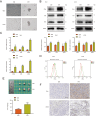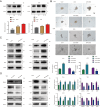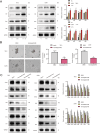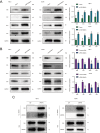ΔNp63α promotes cigarette smoke-induced renal cancer stem cell activity via the Sonic Hedgehog pathway
- PMID: 38985013
- PMCID: PMC11234498
- DOI: 10.1590/1678-4685-GMB-2023-0347
ΔNp63α promotes cigarette smoke-induced renal cancer stem cell activity via the Sonic Hedgehog pathway
Abstract
Cigarette smoke (CS) has been generally recognized as a chief carcinogenic factor in renal cell carcinoma (RCC). The stimulative effect of CS on renal cancer stem cells (RCSCs) has been described previously. The Sonic Hedgehog (SHH) pathway plays an essential role in self-renewal, cell growth, drug resistance, metastasis, and recurrence of cancer stem cells (CSCs). Renal cancer-related gene ΔNp63α is highly expressed in renal epithelial tissues and contributes to the RCSCs characteristics of tumors. The aim of this study was to elucidate the role of ΔNp63α and the SHH pathway on the activity of RCSCs induced by CS through a series of in vivo and in vitro studies. It was shown that in renal cancer tissues, ΔNp63α and RCSCs markers in smokers are expressed higher than that in non-smokers. RCSCs were effectively enriched by tumor sphere formation assay. Besides, CS increased the expression of RCSCs markers and the capability of sphere-forming in vitro and in vivo. Moreover, the SHH pathway was activated, and the specialized inhibitor alleviated the promotion of CS on RCSCs. ΔNp63α activated the SHH pathway and promoted CS-induced enhancement of RCSCs activity. These findings indicate that ΔNp63α positively regulates the activity of CS-induced RCSCs via the SHH pathway.
Conflict of interest statement
Figures







Similar articles
-
Cigarette smoke stimulates the stemness of renal cancer stem cells via Sonic Hedgehog pathway.Oncogenesis. 2018 Mar 13;7(3):24. doi: 10.1038/s41389-018-0029-7. Oncogenesis. 2018. PMID: 29540668 Free PMC article.
-
Sulforaphane Inhibits the Acquisition of Tobacco Smoke-Induced Lung Cancer Stem Cell-Like Properties via the IL-6/ΔNp63α/Notch Axis.Theranostics. 2019 Jul 9;9(16):4827-4840. doi: 10.7150/thno.33812. eCollection 2019. Theranostics. 2019. PMID: 31367260 Free PMC article.
-
Low-dose phthalates promote breast cancer stem cell properties via the oncogene ΔNp63α and the Sonic hedgehog pathway.Ecotoxicol Environ Saf. 2023 Mar 1;252:114605. doi: 10.1016/j.ecoenv.2023.114605. Epub 2023 Feb 6. Ecotoxicol Environ Saf. 2023. PMID: 36753971
-
Unravelling the Mysteries of the Sonic Hedgehog Pathway in Cancer Stem Cells: Activity, Crosstalk and Regulation.Curr Issues Mol Biol. 2024 May 29;46(6):5397-5419. doi: 10.3390/cimb46060323. Curr Issues Mol Biol. 2024. PMID: 38920995 Free PMC article. Review.
-
Cell Fusion, Drug Resistance and Recurrence CSCs.Adv Exp Med Biol. 2011;714:173-82. doi: 10.1007/978-94-007-0782-5_9. Adv Exp Med Biol. 2011. PMID: 21506014 Review.
Cited by
-
The dual role of autophagy in cancer stem cells: implications for tumor progression and therapy resistance.J Transl Med. 2025 May 25;23(1):583. doi: 10.1186/s12967-025-06595-z. J Transl Med. 2025. PMID: 40414839 Free PMC article. Review.
References
-
- Cao WS, Zhao MJ, Chen Y, Zhu JY, Xie CF, Li XT, Geng SS, Zhong CY, Fu JY, Wu JS. Low-dose phthalates promote breast cancer stem cell properties via the oncogene ΔNp63α and the Sonic hedgehog pathway. Ecotoxicol Environ Saf. 2023;252:114605. - PubMed
-
- Ge M, Zhu J, Yi K, Chen Y, Cao W, Wang M, Xie C, Li X, Geng S, Wu J, et al. Diallyl trisulfide inhibits gastric cancer stem cell properties through ΔNp63/sonic hedgehog pathway. Mol Carcinog. 2023;62:1673–1685. - PubMed
LinkOut - more resources
Full Text Sources

